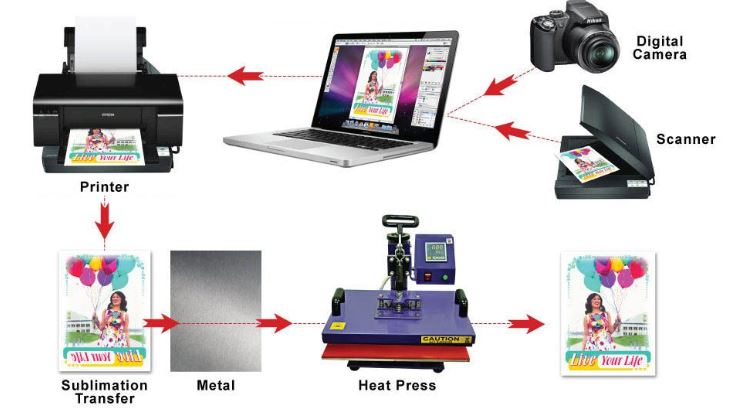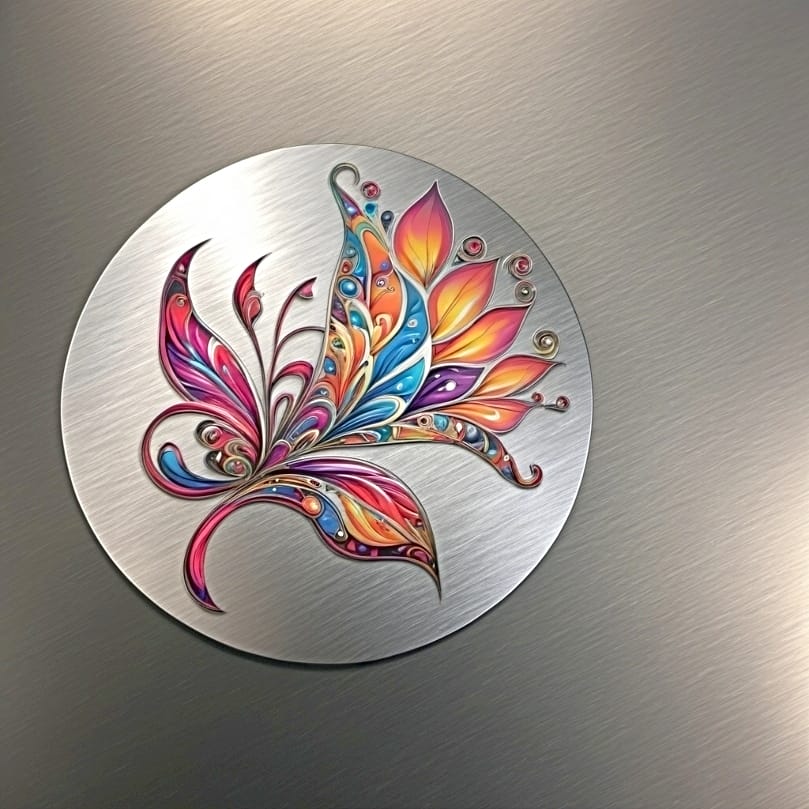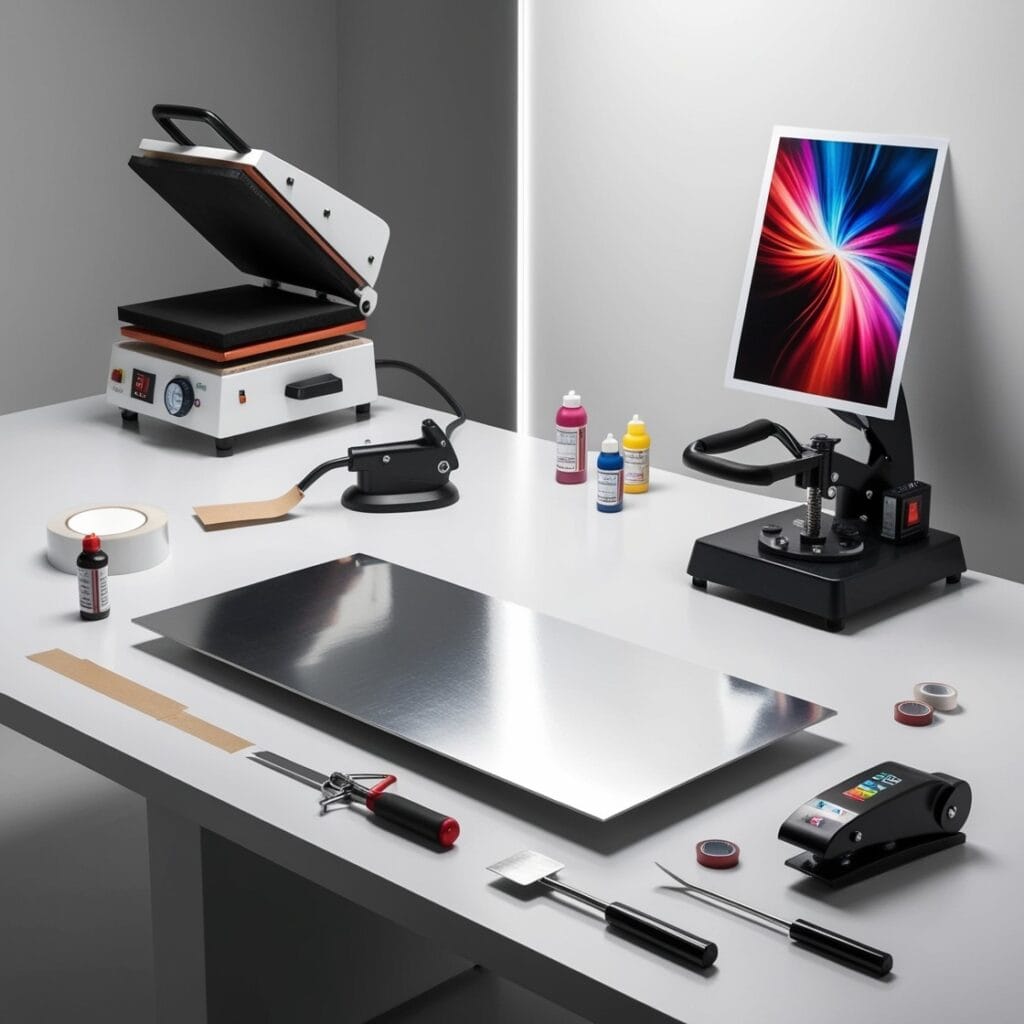BLOG
Sublimation Printing on Metal Tutorial: Achieve Stunning Results Effortlessly
Introduction to Sublimation Printing on Metal

Sublimation printing has emerged as an innovative technique for transferring vibrant and full-color designs onto various materials, including metal. This method allows designers and artists to create high-quality products that stand out due to their durability and aesthetic appeal. In this tutorial, we will delve into the essentials of sublimation printing on metal, helping you achieve stunning results effortlessly.
Overview of Sublimation Printing
Sublimation printing is a process that converts solid dye into gas without passing through a liquid state. This gas then permeates the surface of the substrate—such as metal—creating a permanent bond. The result is a print that is not only rich in color but also resistant to fading and scratching. This technology is particularly popular for creating personalized items, promotional products, and art prints.
Benefits of Printing on Metal
Printing on metal offers a variety of benefits, including:
- Durability: Metal prints are highly resistant to wear and tear, making them ideal for both indoor and outdoor use.
- Vibrant Colors: The sublimation process allows for a wide color gamut, resulting in stunning and vibrant images.
- Finish Options: Metal prints can have a glossy, matte, or brushed finish, giving creators flexibility in design.
- Lightweight: Compared to other materials, metal prints are relatively lightweight, making them easy to handle and display.
These features make sublimation printing on metal a popular choice for artists, photographers, and businesses alike.
How to Prepare Metal for Sublimation Printing
Preparing the metal surface is a crucial step in achieving optimal results with sublimation printing. The following are essential preparatory steps.
Cleaning the Metal Surface
Before applying any sublimation designs, it is essential to clean the metal surface thoroughly. Dust, grease, or any residues can lead to poor adhesion or distorted images. Use a lint-free cloth and a cleaning solution like isopropyl alcohol to wipe down the surface. This not only removes contaminants but also prepares the surface for the sublimation coating.
Applying Sublimation Coating
For metal to accept sublimation dye, it must be coated with a specific sublimation coating. This specialized polymer layer allows the dye to bond effectively during the sublimation process. When applying the coating, ensure an even layer across the entire surface and allow it to cure according to the manufacturer’s instructions. This step is critical for ensuring vibrant and durable prints.
Best Types of Metal for Sublimation Printing
Selecting the right type of metal is crucial for ensuring high-quality results. Certain metals perform better with sublimation techniques than others.
Aluminum vs. Steel
| Feature | Aluminum | Steel |
| Weight | Lightweight | Heavier |
| Cost | Generally more affordable | Typically more expensive |
| Print Quality | Excellent color reproduction | Good but may require special coatings |
| Durability | Highly durable and resistant to rust | Durable but more susceptible to rust without coating |
Aluminum is often favored due to its lightweight nature and excellent color reproduction. Steel, while durable, may require special treatment or coatings to achieve similar quality.
Recommended Coated Metals
For optimal sublimation results, consider the following coated metals:
- Coated Aluminum Sheets: Available in a variety of finishes, such as glossy and brushed, these sheets provide excellent printing quality and vibrant colors.
- Sublimation Steel Blanks: Commonly used for awards and plaques, sublimation-coated steel offers durability and a robust feel.
- Chromaluxe Panels: Known for their high gloss and vivid colors, Chromaluxe provides a premium option for professional-quality prints.
Choosing the right coated metal substrate significantly impacts the final presentation of your sublimated products.
Step-by-Step Metal Sublimation Printing Guide

Design Preparation in Software
Before you start printing, you need to prepare your design in specialized graphic design software. Popular choices include Adobe Illustrator and CorelDRAW, which support vector graphics that are ideal for sublimation.
- Canvas Size: Set your canvas to the exact dimensions of the metal substrate you plan to print on. If the metal sheet is 5″ x 7″, set your document size accordingly.
- Color Mode: Use CMYK color mode, as sublimation printing is typically executed in this format to achieve accurate color representation.
- Bleed Area: Create a bleed area of about 1/8 inch to prevent any unprinted border from showing after trimming.
- Convert Text to Outlines: This step avoids font issues during printing. Convert fonts into vector outlines to preserve your design integrity.
Printing the Transfer
Once your design is ready, it’s time to print.
- Ink Selection: Ensure you’re using sublimation ink specific for your printer model. Brands like Sawgrass or Epson offer high-quality ink that ensures vibrant results.
- Printer Settings: Adjust your printer settings to “High Quality.” Use a resolution of at least 300 DPI to ensure crisp and clear images.
- Test Print: Conduct a test print on regular paper. This allows you to check color accuracy and positioning before using the sublimation paper.
After confirming that everything is in order, print your design onto sublimation transfer paper. Ensure that you select the reverse or mirror image option so that the final print appears correctly on the metal.
Heat Pressing the Metal
The heat press stage is crucial to achieving vibrant results.
- Preparation: Clean the metal surface with isopropyl alcohol to remove any oils or contaminants that could affect adhesion.
- Align the Transfer: Position your printed transfer paper on the metal substrate, ensuring it is centered. Use heat-resistant tape if necessary to keep it in place.
- Heat Press Settings: Set your heat press to the appropriate temperature, typically around 385°F (196°C) for metal substrates, and prepare to press for 60-90 seconds depending on the thickness of the metal.
- Cooling Time: Let the printed metal cool before handling to avoid smudging or distorting the printed image.
Choosing Sublimation Ink for Metal Projects
Types of Sublimation Ink
Not all sublimation inks are the same. The two main types include:
- Dye-based Sublimation Ink: Most common for sublimation printing, recognized for vibrant colors and strong durability on various substrates.
- Pigment-based Sublimation Ink: Offers finer details and is typically used for high-resolution prints, although it might not yield as vivid colors as dye-based options.
Factors to Consider for Metal Printing
When selecting sublimation ink, consider the following factors:
- Compatibility: Ensure the ink is compatible with your printer model.
- Color Accuracy: Check for color profiles and reviews regarding color fidelity on metal.
- Durability: Investigate the ink’s resistance to scratches and fading, especially for products intended for outdoor use.
Best Heat Press Settings for Metal Sublimation
Temperature and Time Settings
The temperature and time settings are vital for a successful transfer. Here’s a general guideline:
| Metal Type | Temperature (°F) | Time (Seconds) |
| Aluminum | 385-400 | 60-90 |
| Steel | 380-390 | 50-70 |
| Coated Metal | 365-375 | 45-60 |
Pressure Considerations
Pressure is an equally crucial aspect of the sublimation process:
- Medium Pressure: Most sublimation jobs on metal require medium pressure to ensure even heat transfer without damaging the substrate.
- Adjust for Thickness: Heavier metals may require increased pressure. Always refer to the manufacturer’s recommendations for the best results.
By following these detailed steps and guidelines, you can achieve stunning sublimation prints on metal with professional results.
Troubleshooting Sublimation Prints on Metal
Common Issues and Solutions
Sublimation printing on metal can occasionally yield results that are less than desirable. Here are some common issues and their respective solutions:
- Faded Colors: This often occurs due to low ink saturation or insufficient heat. Ensure that your sublimation ink is fresh and correctly loaded in your printer. Additionally, check that the temperature and pressure settings on your heat press are optimal.
- Ghosting: Ghosting happens when the transfer paper shifts during the printing process. To avoid this, use heat-resistant tape to secure the transfer paper firmly to the metal surface before pressing.
- Uneven Transfer: If certain areas of the print appear lighter or darker, it could be due to uneven pressure or temperature distribution. It is essential to ensure that your heat press is calibrated correctly and that the metal surface is entirely flat.
- Poor Adhesion: Sometimes, prints may not fully adhere to the metal surface, causing peeling. Properly cleaning the metal surface before application and ensuring that it is specifically coated for sublimation will mitigate this issue.
Tips for Achieving Consistency
To achieve consistently stunning results with sublimation printing on metal, consider the following tips:
- Calibration: Regularly calibrate your printer and heat press. Temperature inaccuracies can result in poor transfers.
- Quality Materials: Use high-quality sublimation inks, transfer papers, and metal substrates. Investing in premium products often results in better prints.
- Testing: Conduct test prints with every batch of materials you use to ensure that color profiles and settings remain consistent.
Using Sublimation Coating Spray for Metal
Application Techniques
Applying sublimation coating spray can significantly enhance your results on metal. Here’s how to do it effectively:
- Preparation: Start by thoroughly cleaning the metal surface to remove any dust or oils. A lint-free cloth and isopropyl alcohol can be ideal for this task.
- Spraying: Hold the spray can approximately 6 to 12 inches away from the surface for an even application. Light, consistent layers are ideal; multiple coats may be necessary for a thicker coverage.
- Drying Time: Allow sufficient drying time between coats, typically around 30 minutes, to prevent drips and ensure an even finish.
Benefits of Coating Spray
Using a sublimation coating spray provides several advantages:
- Improved Image Quality: Coated metals absorb sublimation ink more effectively, leading to sharper and more vibrant images.
- Protection: The coating serves as a barrier against scratches and fading, significantly enhancing the durability of the print.
- Versatile Application: Coating spray can be applied to various metal surfaces, allowing greater flexibility in project options.
How to Make Sublimation Prints Last Longer on Metal
Best Practices for Care and Handling
To prolong the lifespan of sublimation prints on metal, implement these best practices:
- Avoid Direct Sunlight: Prolonged exposure to sunlight can fade colors. If displaying indoors, keep prints away from windows.
- Gentle Cleaning: Use a soft, damp cloth for cleaning. Avoid harsh chemicals that may wear away the coating or print.
- Proper Storage: Store printed metal sheets in a cool, dry place, ideally vertical to minimize contact with surfaces that could scratch the print.
Environmental Factors to Consider
Several environmental factors can impact the longevity of sublimation prints:
- Humidity: High humidity can lead to condensation on metal surfaces, which may affect the adhesion of the print. Consider using dehumidifiers in environments prone to moisture.
- Temperature Fluctuations: Extreme temperature changes can cause warping or peeling of the print. Maintaining a consistent temperature in storage or display areas is advisable.
Creative Ideas for Sublimation Metal Prints

Sublimation printing offers a wide range of possibilities, allowing for creative applications on metal:
- Personalized Gifts: Create unique, personalized metal signs or photo frames as gifts for special occasions. Customization can include names, dates, or memorable quotes.
- Interior Decor: Use large sublimated metal panels as wall art. Vivid landscapes or abstracts can create unique focal points in living spaces.
- Promotional Products: Businesses can utilize sublimation printing on metal for creating promotional items, such as coasters, keychains, or signage. This method not only achieves stunning visuals but also enhances brand visibility.
- Awards and Recognition: Design custom trophies or plaques for events or achievements. The durability of metal combined with vibrant designs makes for impressive recognition pieces.
By leveraging these ideas and techniques, users can achieve impressive results with sublimation printing on metal while ensuring the longevity and quality of their creations.
Unique Project Ideas
Sublimation printing on metal offers a wide array of project possibilities that can cater to both personal and professional needs. Here are some unique project ideas that can inspire your creative journey:
- Custom Awards and Trophies: Personalizing awards with sublimation printing can enhance their appeal. For instance, you can create metal plaques for sports achievements, academic excellence, or corporate recognitions. Using high-quality metal substrates can ensure durability and a professional finish.
- Decorative Wall Art: Create stunning wall displays by printing images or designs onto aluminum panels. Not only do these pieces add character to living spaces, but they can also be sold as unique home decor items. For example, printing nature photography on brushed aluminum can result in an eye-catching piece.
- Photo Gifts: Personalized gifts like metal photo frames or customized coasters make excellent keepsakes. For example, you can print family portraits on aluminum coasters, making them ideal for both practical use and display.
- Business Signage: Enhance your branding with sublimated metal signs. They can be used for storefronts, office decor, or directional signs. Using reflective and vibrant colors can significantly improve visibility and attractiveness, leading to potential increases in foot traffic.
- Outdoor Decorations: Metal sublimation prints are resistant to fading, making them suitable for outdoor use. Consider creating personalized garden signs, birdhouses, or decorative outdoor panels to elevate exterior aesthetics.
Incorporating Personalization Techniques
Personalization is a key factor in the effectiveness of sublimation projects. Here’s how to incorporate various techniques into your designs to elevate the final product:
- Custom Text and Quotes: Adding names, quotes, or special dates can enhance the meaning of the project. For example, a personalized photo plaque can feature a memorable date alongside an image, making it a treasured keepsake.
- Color Variations: Use vibrant colors that complement the design. According to research, the right color choices can increase viewer engagement by 80%. Be sure to use high-quality inks during the sublimation process to achieve lasting color vibrancy.
- Patterns and Textures: Introducing unique patterns or textures can set your projects apart. For instance, utilizing a matte finish can create a more modern look, while a glossy finish may appeal more to traditional aesthetics.
- Incorporating Graphics and Icons: Consider adding logos or custom graphics that reflect individual or business branding. This technique can be especially beneficial for business-related projects, as it reinforces brand identity.
- Interactive Elements: Create projects that invite interaction, such as metal prints with chalkboard surfaces for customizable messages. This adds a dynamic layer to decoration, allowing users to change the display, enhancing engagement over time.
Conclusion
Sublimation printing on metal not only allows for stunning visual effects but also opens up a realm of creative possibilities. Unique project ideas like custom awards, decorative wall art, and personalized gifts can cater to a variety of needs, from personal keepsakes to professional branding. Incorporating personalization techniques, such as custom text, vibrant color variations, and unique patterns, significantly enhances the emotional value and appeal of each item. By understanding and applying these aspects, you can achieve remarkable results that truly stand out, whether for personal projects or commercial endeavors. Choose to create meaningful, high-quality sublimation products that leave a lasting impression in any setting.

